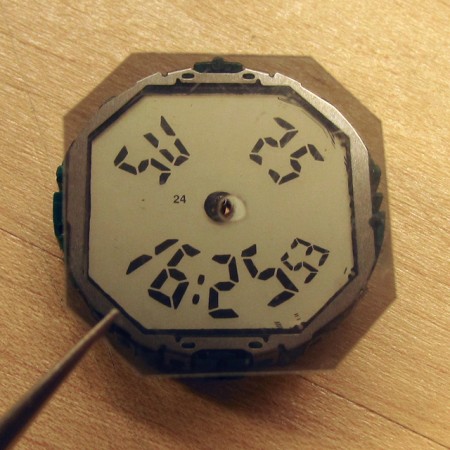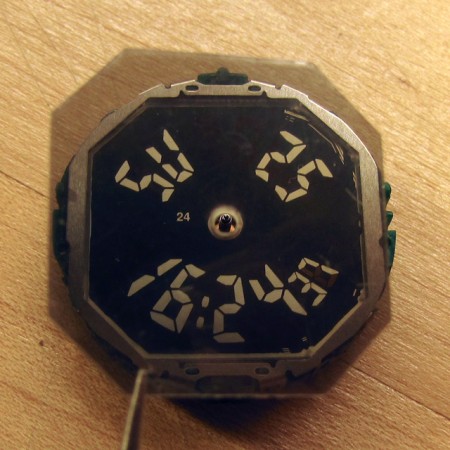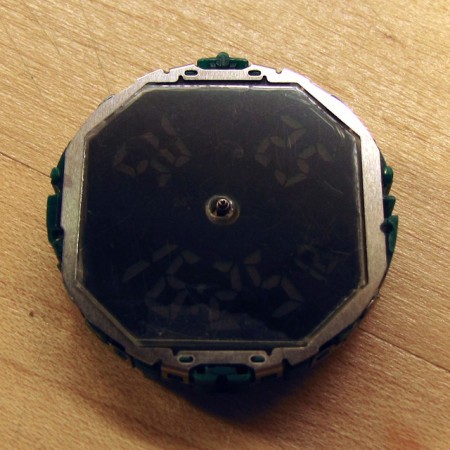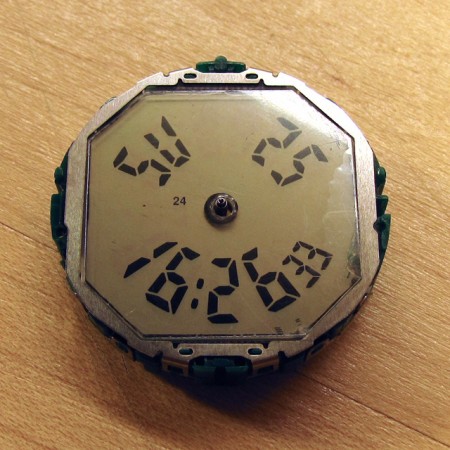Why Negative LCDs Are So Hard to Read
December 3, 2013
Many watches have a so-called “negative” liquid crystal display (LCD), where the background is dark and the digits are light. I’ve often read complaints on the WatchUSeek forums about them being difficult to read in less than perfect lighting conditions, and I began to wonder why. I think I’ve figured it out.
While working on a project watch, I took the opportunity to experiment and take some pictures. First, here’s the LCD from my project watch. I had already removed the original polarizing filter and prepared a new one, which still has its protective film on it and is just lying on top of the LCD here (the display didn’t look any better with the original filter):
All LCDs, even non-backlit ones like those used in watches and calculators, work by passing or blocking light that comes from behind the LCD. They do this by selectively polarizing the light (by manipulating the already-polarized light coming from behind the LCD), and then passing it through the polarizing filter on the front of the LCD. If the polarization is aligned, the LCD is light at that location, and if it’s at right angles, the LCD is dark at that location. It’s very easy to turn a negative LCD into a positive one (or vice versa) by just rotating the filter 90 degrees:
In the case of a non-backlit LCD, that light from behind the LCD is actually reflected ambient light, meaning that it must first pass through the front of the LCD, passing through two polarizing filters, bounce off of the reflective back, and then come back out.
Therein lies the problem. With a negative LCD, very little light actually makes it to the reflector, since all of it has to come in through the digits because the rest of the display is opaque. If the reflector were a perfect mirror, this wouldn’t matter, since the light entering at one spot would be the same light leaving at that spot. But the reflector is not a perfect mirror. It scatters the light, so some of the light that enters never leaves. I suspect that with a negative LCD, most of the light that enters is wasted. Hence, with very little light coming in, and much of that not coming back out, the digits are very dim.
With a positive LCD, most of the light that enters does leave, because only a small percentage of it is blocked by the displayed digits (since they take up only a small percentage of the total display area). Thus the background on a positive LCD is much brighter than the digits on a negative one (whereas the black areas are equally dark on both). Thus the positive LCD has much higher contrast.
To lend some credibility to this explanation, I’ve photographed the LCD in both positive and negative modes with the filter held about 5cm above the display. This way, a large amount of ambient light can reach the reflector without having to pass through the filter at all. First, the positive mode:

With the filter held a short distance above the positive display, the contrast is about the same as with the filter installed.
Notice there’s very little difference. A little bit more light gets in, but not much more than before, because a lot was already getting in through the filter when it was in place. But now look at the same thing in negative mode:

The negative display with the filter held a short distance above it has as much contrast as the positive one.
The difference is like night and day (quite literally). The reflector is now getting almost as much light as it does in positive mode, so the digits are almost as bright in negative mode as the background is in positive mode.
It’s no surprise that (at the time of this writing), 22 of the 24 highest rated digital watches on Amazon used a positive display.
So how could this information be used to make a legible negative LCD watch? First, the polarizing filter would need to be a significant distance from the screen. Next, light needs to be able to get around the polarizer. That means that some area around it needs to be transparent, or at least translucent. This would be hard to do with a full-dial LCD like this one, but might work with a small one-line display embedded in a translucent watch face or analog dial. I also suspect that the smaller the LCD, the closer the filter can be yet still allow enough light in from the sides.
A note on the pictures. All were taken with the camera in auto macro mode, but in each case, the camera was first allowed to focus and adjust the lighting on the LCD with no filter at all. Thus, the exposures are all roughly the same.
Related Articles
If you've found this article useful, you may also be interested in:
- Building a Musical Sunrise Quartz Alarm Clock
- Making Custom Watch Dials
- A Riff on a Russian Navigator’s Watch
- Turn a NATO Strap into a Two Piece Watch Strap
- Restoring a Mechanical Russian Alarm Watch
- Repairing a Scratched Acrylic Watch Crystal

If you've found this article useful, consider leaving a donation in Stefan's memory to help support stefanv.com
Disclaimer: Although every effort has been made to ensure accuracy and reliability, the information on this web page is presented without warranty of any kind, and Stefan Vorkoetter assumes no liability for direct or consequential damages caused by its use. It is up to you, the reader, to determine the suitability of, and assume responsibility for, the use of this information. Links to Amazon.com merchandise are provided in association with Amazon.com. Links to eBay searches are provided in association with the eBay partner network.
Copyright: All materials on this web site, including the text, images, and mark-up, are Copyright © 2025 by Stefan Vorkoetter unless otherwise noted. All rights reserved. Unauthorized duplication prohibited. You may link to this site or pages within it, but you may not link directly to images on this site, and you may not copy any material from this site to another web site or other publication without express written permission. You may make copies for your own personal use.


paul
December 15, 2014
Great read and very informative. Thank you.
Vedran
April 11, 2017
I had a Panasonic car stereo (aprox. 1992) which had a button for reversing display polarisation.